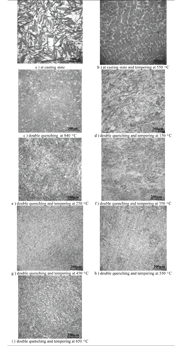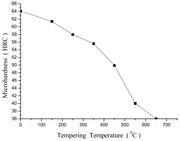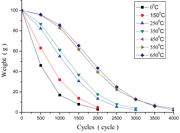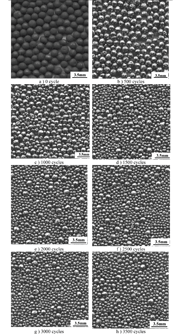E-Archive
Science Update
in Vol. 9 - September Issue - Year 2008
Effect of Double-quenching and Tempering Treatment on the Micro-structure and ERVIN Life of the High Carbon Cast Steel Shot

Table1 Characteristics of the as-cast high carbon cast steel shot

Figure 1: The microstructures of the high carbon cast steel shot samples

Figure 2: The sample hardness after double-quenching and tempering at various temperatures

Figure 3: The breakdown curve of the samples at various tempering temperatures

Figure 4: The wearing morphology of the samples with the hardness of HRC 40 after double-quenching and tempering at 550
The high carbon cast steel shot was heated to 840°C for 30 minutes, double water quenched and then tempered at various temperatures from 150°C to 650°C, the tempering temperature was kept for 30 minutes. The effect of the tempering temperature on the hardness, the microstructure and the ERVIN life were studied. The results show that the higher the tempering temperature is, the lower the hardness of the high carbon cast steel shot is; the microstructure of the shot transforms from tempered martensite to tempered troostite or tempered sorbite, and the ERVIN life, as characterized by the breakdown curve, becomes longer. Keywords: high carbon cast steel shot; double-quenching; tempering; microstructure; ERVIN life; hardness
1. Introduction
The as-cast high carbon cast steel shot sample used in this experiment, manufactured by Shandong Kaitai Metal Abrasive Co. Ltd, as shown in table 1, is melted by using a medium frequency induction furnace and formed by centrifugal atomizing method. The samples are in good spherical shape with the least amount of irregular particles. In regular production, the high carbon cast steel shot is heated continuously in furnace and the quenching and tempering preserving time is about half an hour, so 30 minutes is chosen as the preserving time in this study, in the meanwhile, the box resistor stove is used as the heating device. 840°C is chosen as the double quenching temperature. At this temperature the iron is in the austenite region above the Acm. Water is used as the cooling medium, this will eliminate the dendrite formed by the rapid solidification during the centrifugal atomizing process. This Water quenching will also diffuse the compound uniformly and preserve a portion of granular carbides, which contribute to the sample`s hardness and wearability. In standard ISO11124-3 [1] and SAE J827 [2], it states that the microstructure of the high carbon cast steel shot is tempered martensite or tempered troostite with the hardness of HRC 40-50 or HV 390-530. Using the standards as guideline, six various tempering temperatures ranging from 150°C to 650°C are chosen and samples are air-cooled. The processed samples are etched by the alcohol solution with 4% of nitric acid and then studied for microstructures with a metalloscope. The micro-hardness of the processed sample is tested by using the vickers hardness tester with a 500g load. The ERVIN life is represented by the breakdown curve, which is quantified by using an ERVIN test machine. The ERVIN life test procedure is performed by placing 100g of the sample in the ERVIN test machine; running 500 cycles and then screening the samples through a sieve with a 0.6mm diameter mesh; weighing the retained sample; finally returning the remaining samples back to Ervin test machine to continue the next 500 cycles till less than 5% of the sample are left[3,4].
2. Test result and its Analysis
2.1 Microstructure
As shown in Figure 1 (a), the microstructure of the as-cast high carbon steel shot is the high carbon lenticular martensite and the retained austenite, which is transformed from the dendritic austenite with serious composition segregation due to the rapid solidification during the centrifugal atomizing process. This process is equivalent to the single quenching process, i.e. the first martensitic transformation process. Due to the micro-cracks caused by the impact of the brittle martensite plate[5,6] and the retained austenite, this microstructure always has a lower hardness which is only about HRC 60.1. If the as-cast high carbon cast steel shot is directly tempered, the composition segregation is hardly eliminated, see Figure 1 (b). When the as-cast sample is tempered at 550°C and preserved for 30 minutes, the microstructure shows that the carbide segregates at the boundaries of the dendrites austenite, it is easy to break up and has a short life span.
After the sample is double quenched at 840°C for 30 minutes, the microstructure is transformed to fine cryptocrystalline martensite with little retained austenite and some unsolvable granular carbides, see Figure 1 (c). The composition segregation is improved while the hardness increases to HV 803.8 ( HRC 63.1 ). Figure 1 (d) through Figure 1 (i) show that by tempering at various temperatures, the cryptocrystalline martensite and the retained austenite go through a decomposition process and transform into carbides and ferrite i.e. the microstructure is transformed from tempered martensite to tempered troostite and tempered sorbite[6,7].
2.2 Microhardness
Figure 2 shows the effects of the various tempering temperatures on the hardness when the sample is double quenched and then tempered; when the tempering temperature increases, the microhardness decreases gradually from HV 803.8 (HRC63.1), which is the hardness of the sample after double-quenching and no tempering, to HV336.7 (HRC36.1), which is the hardness of the sample after double-quenching and tempering at 650°C. As recommended by ISO 11124-3[1] and SAE J827[2], the hardness of the high carbon cast steel shot should be HRC40-50, so based on the curve in Figure 2, we conclude that the tempering temperature after double-quenching should be controlled at 400°C-550°C. We can also achieve desired microhardness by choosing different tempering temperatures.
2.3 ERVIN Life
When evaluating the average ERVIN life by the area under the breakdown curve, the ERVIN life is equal to the sum of the areas divided by 100% [3,4], so the ERVIN life is proportional to the sum of the areas under the breakdown curve. Figure 3 shows that as the tempering temperature increases, the breakdown curve extends further. This implies that the sum of the area under the curve gets larger and the ERVIN life prolongs gradually. From Figure 3, it can also be found that the Ervin life of the samples after double quenching and tempering is longer than the ERVIN life of the samples with only double quenching but no tempering. It’s because the martensite and the retained austenite in the sample are decomposed and transformed to the ferrite and carbide in the quenching and tempering process. The transformation from the hard and brittle martensite to the soft ferrite and carbide improves the sample’s resistance to impact and deformation capability and hence reduces the wear rate.
Figure 4 shows the picture of morphology of the sample at various cycles of Ervin life test and the breakdown powder of the sample. The sample used here has the hardness of HRC40 (HV377) after double quenching and tempering at 550°C. A sieve with 0.6mm diameter is used to separate the sample and the breakdowns. It is clear that the average diameter of the shot gradually decreases. Figure 4 (b) shows the sample after 500 cycles, most of the shots are deformed into spherical shape with many surfaces after multiple hits to the target of the ERVIN test machine, which has a hardness above HRC63. It also shows that a portion of samples with defects of porosity or micro crack are broken down and then rounded again, this is kind of ductile fracture. The figures from Figure 4 (b) to Figure 4 (i) show that the small shots as well as the large shots are gradually broken down and the broken grains are gradually rounded again. Some shots with little defects can hold up to 4000 cycles, these shots show minimal reduction of the size with a compact and uniform microstructure. The grain of the breakdown powder, see Figure 4 (j), is of irregular shape and a small diameter, this powder does not have enough kinetic energy to offer any blast cleaning ability[3].
2.4 Conclusion
The microstructure of the as-cast high carbon cast steel shot is high carbon lenticular martensite and retained austenite with severe composition segregation. After double quenching at 840°C , the microstructure is transformed to the fine cryptocrystalline martensite with little retained austenite and a portion of the unsolvable granular carbonides; high tempering temperature will transform the microstructure from the tempered martensite to the tempered troostite and tempered sorbite. Double quenching and tempering will reduce the microhardness of the high carbon cast steel shot gradually as the tempering temperature increases. According to the statements regarding the high carbon cast steel shot standard ISO11124-3[1] and standard SAE J827 [2], the hardness of the high carbon cast steel shot should be HRC40-50, the tempering temperature should be controlled between 400°C and 550°C in order to achieve this hardness. For a given desired hardness, the tempering temperature can also be decided by using the curve derived in this study. After double quenching and tempering, the ERVIN life of the high carbon cast steel shot increases as the tempering temperature increases and it shows the improvement of the durability and the reduction of the wear rate.
2.5 References
1. SO11124-3.1993, Preparation of steel substrates before application of paints and related productions – Specifications for metallic blast – cleaning abrasives - Part 3: High-Carbon Cast-Steel Shot and Grit.
2. SAE J827.1996, High-Carbon Cast-Steel Shot.
3. Ervin Industries. 2002, The Ervin Test Machine.
4. SAE J455APR96. January 1996, Metallic Shot And Girt Mechanical Testing.
5. Zuyao Xu.1980.3, Martensitic transformation and Martensite. Beijing, pp.178-190.
6. R W K Honeycombe. 1981, Steels Microstructure and Properties. London: Edward Arnold Ltd, pp.140-165.
7. Zhengfeng Qi. 1988.6, Heat Treatment Principles for Metals. Beijing, pp.155-171
8. Ruwei Liu. 1996.5, Analysis of Several Questions Associated with Abrasive for Shotblast Cleaning of Castings .Foundry, No.5, pp.23-25.
9. Ruwei Liu. 2004.2, Comparative Analysis of Abrasive for Shot Blasting Steel Structure. Steel Construction,Vol.19, No.71, pp.70-71.
10. A.Hatano and K.Namiki, Daido Steel Co.,Ltd. 1990.5, Development Of Hard And Tough Steel Shot. ICSP-4 , pp.37-46.
Xinhua Zhao (1), Ruwei Liu (1), Hongju Gao(1), Laibin Zhang(2), Ruiguo Wang(2)
(1) College of Material Science and Engineering, Shandong University, Jinan 250061, P.R. of China
(2) Shandong Kaitai Metal Abrasive Co., Ltd, Zouping 256217,
P.R. of China
For Information contact Mr. Ruwei Liu: E-mail: liuruwei@sdu.edu.cn



























